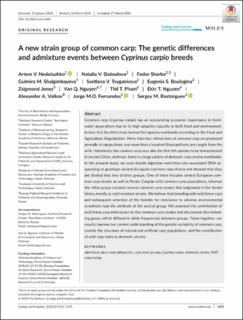A new strain group of common carp: The genetic differences and admixture events between Cyprinus carpio breeds
Nedoluzhko, Artem; Slobodova, Natalia; Sharko, Fedor S.; Shalgimbayeva, Gulmira; Tsygankova, Svetlana V.; Boulygina, Eugenia S.; Jeney, Zsigmond; Nguyen, Van Q.; Pham, Thế T.; Nguyen, Duc T.; Volkov, Alexander; Fernandes, Jorge Manuel de Oliveira; Rastorguev, Sergey M
Peer reviewed, Journal article
Published version
Permanent lenke
https://hdl.handle.net/11250/2663648Utgivelsesdato
2020Metadata
Vis full innførselSamlinger
Originalversjon
Nedoluzhko, A. V., Slobodova, N. V., Sharko, F., Shalgimbayeva, G. M., Tsygankova, S. V., Boulygina, E. S., Jeney, Z., Nguyen, V. Q., Pham, T. T., Nguyen, D. T., Volkov, A. A., Fernandes, J. M. O. & Rastorguev, S. M. (2020). A new strain group of common carp: The genetic differences and admixture events between Cyprinus carpio breeds. Ecology and Evolution, 10(12), 5431-5439. doi: 10.1002/ece3.6286Sammendrag
Common carp (Cyprinus carpio ) has an outstanding economic importance in freshwater aquaculture due to its high adaptive capacity to both food and environment. In fact, it is the third most farmed fish species worldwide according to the Food and Agriculture Organization. More than four million tons of common carp are produced annually in aquaculture, and more than a hundred thousand tons are caught from the wild. Historically, the common carp was also the first fish species to be domesticated in ancient China, and now, there is a huge variety of domestic carp strains worldwide. In the present study, we used double digestion restriction site‐associated DNA sequencing to genotype several European common carp strains and showed that they are divided into two distinct groups. One of them includes central European common carp strains as well as Ponto–Caspian wild common carp populations, whereas the other group contains several common carp strains that originated in the Soviet Union, mostly as cold‐resistant strains. We believe that breeding with wild Amur carp and subsequent selection of the hybrids for resistance to adverse environmental conditions was the attribute of the second group. We assessed the contribution of wild Amur carp inheritance to the common carp strains and discovered discriminating genes, which differed in allele frequencies between groups. Taken together, our results improve our current understanding of the genetic variability of common carp, namely the structure of natural and artificial carp populations, and the contribution of wild carp traits to domestic strains.

